Top 100 Picture Books #17: The Story of Ferdinand by Munro Leaf, illustrated by Robert Lawson
 #17 The Story of Ferdinand by Munro Leaf, illustrated by Robert Lawson (1936)
#17 The Story of Ferdinand by Munro Leaf, illustrated by Robert Lawson (1936)
73 points
I remember liking this as a child, but I love it even more as a parent, when my children love to listen to it. It’s a gentle story, and can sometimes be calming at bedtime, but they also love to run around the house yelling “Wow! Did it hurt!” regarding the bumblebee scene. – Libby Gorman
What a beautiful message about being true to who you are! The simple sketches by Robert Lawson are fantastic. – Alexandra Eichel
Because, with a mix of humor and gravity, it sustains many very different interpretations. – Philip Nel
I was the Ferdinand in my family of birth. – Laura Gallardo
True story. I walk into the local Aveda to get my hair styled and the fellow they’ve given me is a chatty sort. Wants to talk to me about my job, librarianship, that sort of thing. And in the midst of our conversation I somehow steer it over to the Top 100 Picture Books poll and the books that did particularly well. He doesn’t remember the names of children’s books, but he brings up (of all things), “That story about the bull with the flowers.” “Ferdinand?”, I ask. “That’s the one!” That leads into a conversation of the book, the fact that his roommate has that bull tattooed onto his back (this is true), and the controversy surrounding it . . . but I get ahead of myself. In any case, clearly this book is on the minds of the non-children’s picture book reading public at large as well as the fans of the field.
Children’s Literature described the plot as, “Set in Spain, it is about a young bull named Ferdinand. All bulls in Spain aspire to one day fight in the ring with a matador. But not Ferdinand. All day long the young bulls play at fighting in hopes that one day they will be strong enough to be chosen for the bullfights. But Ferdinand prefers to quietly sit in the pasture and enjoy his surroundings. When the bulls all mature, they long to be selected for the bullring…all but Ferdinand. As the other bulls prance and preen, hoping to be selected, Ferdinand ignores the commotion. Suddenly, Ferdinand is stung by a bumblebee. He bellows and dances around like crazy. The matadors are so impressed with his machismo they select him as the strongest bull. He is praised all around for his power, until the day of the bullfight. Poor Ferdinand just sits there. The matadors prod and coax with no luck. Ferdinand is not interested in fighting. Ferdinand is returned to his pasture to live out his life in solitude.”
In any case, this is a lovely banned book to place on the list. Banned by whom? Oh, nobody much. Just a fellow by the name of Adolf Hitler. You see it was published during the Spanish civil war, Franco banned it in Spain, and then Hitler goes and calls it “degenerate democratic propaganda.” 100 Best Books for Children does say that it had its admirers as well, though. “Thomas Mann, H.G. Wells, Gandhi, and Franklin and Eleanor Roosevelt.” So, to sum up. Hitler hated it and Gandhi loved it. That’s a fine pedigree for this list, I should think.
In Tales for Little Rebels, there’s quite the lovely section dedicated to the book. “When the book was published in the fall of 1936, critics accused Ferdinand of being communist, pacifist, and fascist, and of satirizing communism, pacifism, and fascism. . . . Whatever Ferdinand’s politics, he became a cultural phenomenon, appearing as a balloon ini Macy’s Thanksgiving Parade, as the star of an Oscar-winning Disney cartoon short (1938), and as the subject of a popular song.”
Want to see the Disney short alluded too? Here it is:
I find the elements of the book, from the cover to the corks, that have been worked into the movie to be fascinating.
In 2011 there was an article in Vulture entitled Fox, Ice Age Director Bullish on The Story of Ferdinand. For a second there it looked as if a new CGI Ferdinand would be hitting theaters. A quick check of IMDB, however, does not reveal anything to be in the works. A narrow escape? You be the judge.
But let’s get back to the controversy surrounding the title. According to Minders of Make-Believe everyone had an opinion on the title. So much so that the great librarian Anne Carroll Moore finally had to weigh in. “Far be it from the artist, the author or the critic Owl to read meanings into Ferdinand, that effortless, happy collaboration of Munro Leaf and Robert Lawson. They have never had any doubt that Ferdinand was designed for sheer entertainment of the ageless.” Good woman. But was it true? Did Leaf really not intend to make any kind of a political statement? Ferdinand is a Spanish bull and Spain was the center of quite a lot of political activity, after all. Yet in 1936 in The New York Times Leaf said that the book had just been something he worked out on a rainy Sunday for his friend Robert Lawson. Lawson had complained that he was feeling limited by the publishers so Leaf said to him, “Rob, cut loose and have fun with this.” The result, as Minders puts it, is that, “If The Story of Ferdinand had any hidden meaning, it lay in the inspiration to be gleaned from the example of a free spirit unleashed against great odds.”
So why a bull? According to 100 Best Books for Children, Munro Leaf said it was because, “dogs, rabbits, mice and goats had all been done a thousand times.” Ah yes. How well we all remember that famous goat . . . um . . . wait, goats?
Choke back your horror when you hear this, though. In 2000 an edition of the book was produced where Lawson’s otherwise perfect illustrations were colorized. Oh the horror . . . the horror . . .
- Be sure to check out Bottom Shelf Book’s piece on Ferdinand and Lawson’s strange inclusion of vultures in the text.
- And for a wonderful take on a fellow Robert Lawson title They Were Strong and Good, Collecting Children’s Books had a particularly nice post.
- Finally, the influence of the book has spread far and wide. And most strangely, in my opinion, was the fact that it brought about the title of the third Fall Out Boy album From Under the Cork Tree.
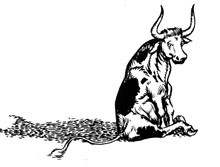
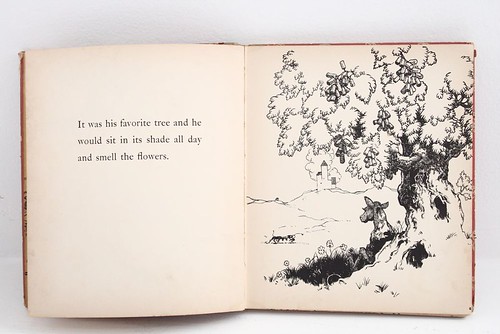
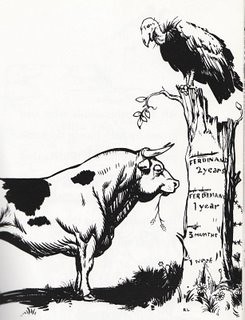
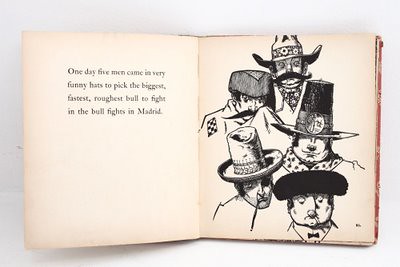
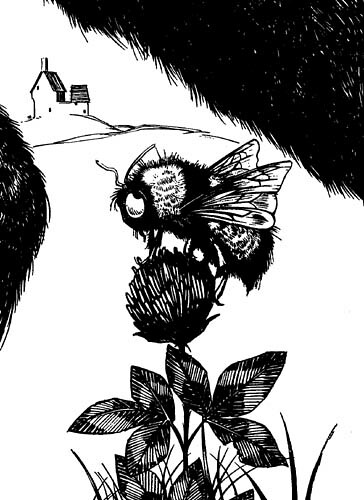

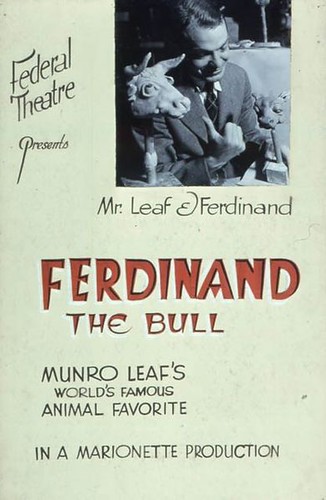
Filed under: Best Books, Top 100 Picture Books Poll
About Betsy Bird
Betsy Bird is currently the Collection Development Manager of the Evanston Public Library system and a former Materials Specialist for New York Public Library. She has served on Newbery, written for Horn Book, and has done other lovely little things that she'd love to tell you about but that she's sure you'd find more interesting to hear of in person. Her opinions are her own and do not reflect those of EPL, SLJ, or any of the other acronyms you might be able to name. Follow her on Twitter: @fuseeight.
ADVERTISEMENT
ADVERTISEMENT
SLJ Blog Network
2024 Books from Pura Belpré Winners
Winnie-The-Pooh | Review
Parsing Religion in Public Schools
Finding My Own Team Canteen, a cover reveal and guest post by Amalie Jahn
ADVERTISEMENT







I love Ferdinand. And this post reminds me that I need to pick up a copy of this book for my oldest girl, who is definitely the person who doesn’t actively go against the crowd, but certainly refuses to fit into any typical molds.
If I could only read one book to a child, this would be it. Such a timeless message we all need to remember.